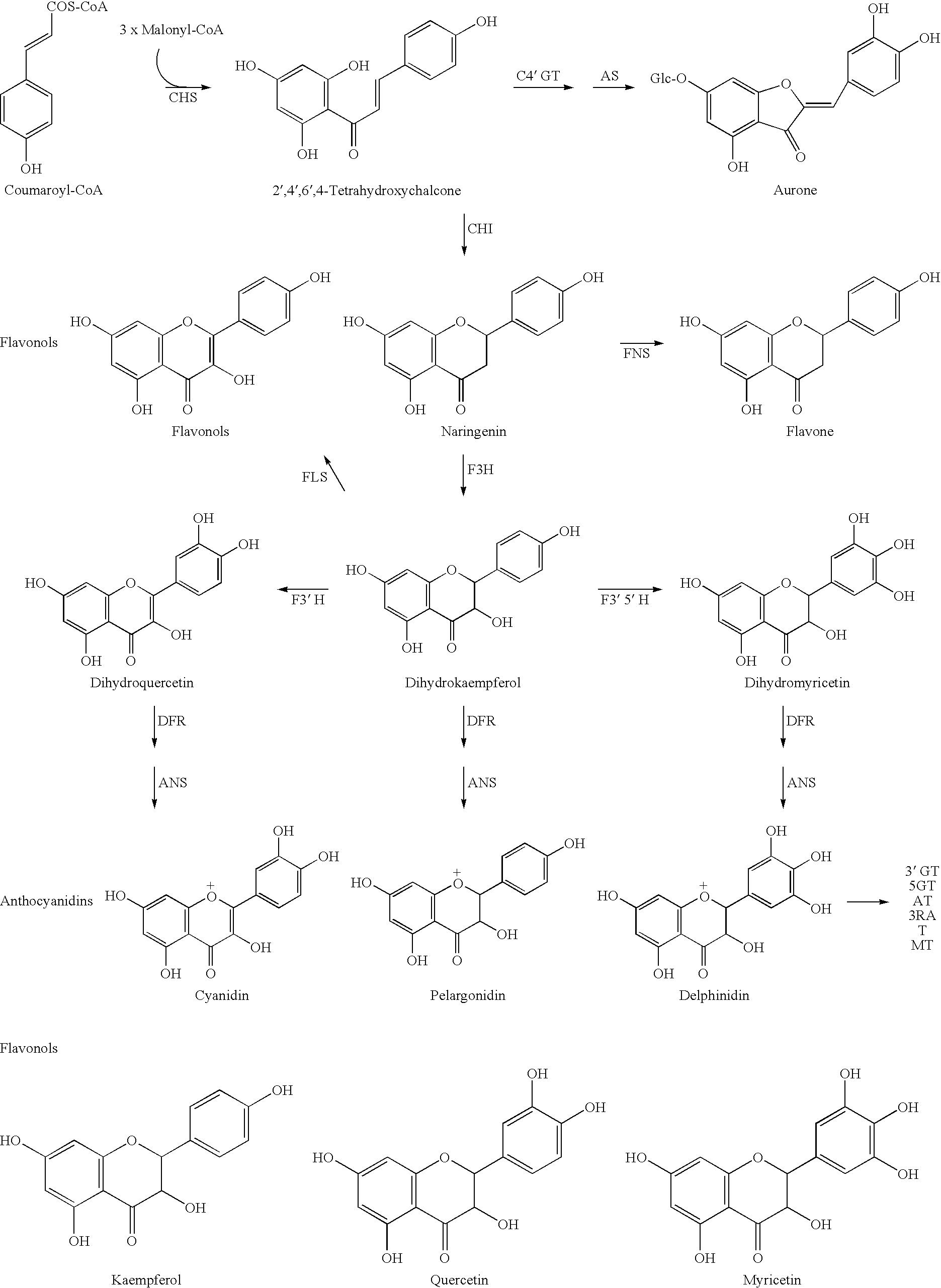Rose containing flavone and delphinidin, and method for production thereof
a technology of flavone and delphinidin, which is applied in the field of artificially made roses containing flavone and delphinidin, can solve the problems of difficult to predict whether the function of the gene will be fulfilled, the function of genes is lost, and it is difficult to infer the function of the gene derived from which plant varieties
- Summary
- Abstract
- Description
- Claims
- Application Information
AI Technical Summary
Benefits of technology
Problems solved by technology
Method used
Image
Examples
example 1
Simulation of Flavone Copigment Effect with Anthocyanins
[0079]Anthocyanins were prepared first for simulation of the flavone copigment effect with anthocyanins. Cyanin was extracted and purified from petals of the rose variety “Rote Rose” (rose cv. “Rote Rose”). Delphin was obtained by alkali hydrolysis of the pigment extracted from petals of the verbena variety “Tapien Violet” (verbena cv. “Tapien Violet” or verbena variety Sunmaref TP-V (“Tapien Violet”) (“Tapien” is a Trade Mark registered in Japan)), followed by purification. Malvin and luteolin 7-O-glucoside were purchased from Funakoshi Corp.
[0080]The flavone (luteolin 7-O-glucoside) was added to each anthocyanin prepared in this manner, at 0, 1, 2 and 4 equivalent molar concentrations in a buffering solution at pH 5.0, and the absorption spectra were measured. The anthocyanins used were cyanin (cyanidin 3,5-diglucoside), delphin (delphinidin 3,5-diglucoside) and malvin (malvidin 3,5-diglucoside). The anthocyanin concentration...
example 2
Reference Example
Transfer of Pansy F3′5′H#40 Gene and Perilla Flavone Synthase Gene into Rose Variety “Lavande”
[0082]The perilla flavone synthase gene-containing plasmid pYFS3 described in Japanese Unexamined Patent Publication No. 2000-279182 was digested with XbaI and then blunt ended and digested with BamHI to obtain an approximately 1.8 kb perilla flavone synthase gene fragment. Separately, pSPB906 described in WO2005 / 017147 was digested with XhoI and then blunt ended and further digested with BamHI. The perilla flavone synthase gene fragment was inserted between the flush ends and the BamHI cleavage site to obtain plasmid 906-pYFS3. Plasmid 906-pYFS3 comprises the perilla flavone synthase gene between the El235S promoter and D8 terminator (both described in WO2005 / 017147).
[0083]A plasmid obtained by inserting a fragment of the pansy F3′5′H#40 gene, cut out from pCGP1961 described in WO2005 / 017147 by partial digestion with BamHI and XhoI, at the BamHI and SalI sites of pSPB176 r...
example 3
Transfer of Pansy F3′5′H#40 Gene and Torenia Flavone Synthase Gene into Rose Variety “Lavande”
[0086]A plasmid obtained by inserting the torenia flavone synthase gene reported by Akashi et al. (Plant Cell Physiol 40, 1182-1186, 1999) at the EcoRI and XhoI sites of plasmid pBluescript II SK(−) was designated as pSPB426. After digestion of this plasmid with KpnI, it was blunt ended and further digested with BamHI to obtain an approximately 1.7 kb torenia flavone synthase gene fragment. Separately, pSPB906 described in WO2005 / 017147 was digested with XhoI and then blunt ended and further digested with BamHI. The torenia flavone synthase gene fragment was inserted between the blunt ends and the BamHI cleavage site to obtain plasmid 906-426.
[0087]A plasmid obtained by inserting a fragment of the pansy F3′5′H#40 gene, cut out from pCGP1961 described in WO2005 / 017147 by partial digestion with BamHI and XhoI, at the BamHI and SalI sites of pSPB176 reported by Ueyama et al. (Ueyama et al. Pla...
PUM
| Property | Measurement | Unit |
|---|---|---|
| pH | aaaaa | aaaaa |
| pH | aaaaa | aaaaa |
| angle | aaaaa | aaaaa |
Abstract
Description
Claims
Application Information
 Login to View More
Login to View More - R&D
- Intellectual Property
- Life Sciences
- Materials
- Tech Scout
- Unparalleled Data Quality
- Higher Quality Content
- 60% Fewer Hallucinations
Browse by: Latest US Patents, China's latest patents, Technical Efficacy Thesaurus, Application Domain, Technology Topic, Popular Technical Reports.
© 2025 PatSnap. All rights reserved.Legal|Privacy policy|Modern Slavery Act Transparency Statement|Sitemap|About US| Contact US: help@patsnap.com



